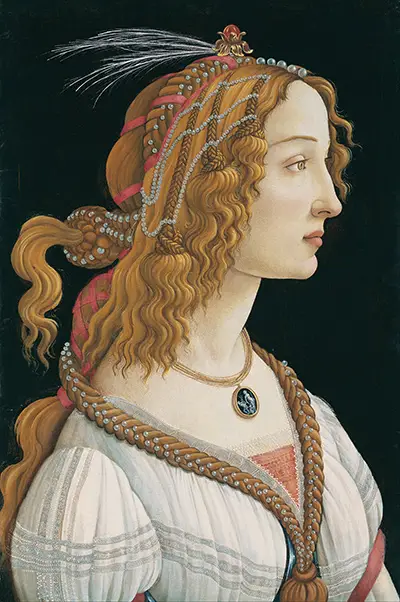It is thought that the subject of the painting was Simonetta Vespucci. Many believed her to be the most beautiful woman in Florence during this time.
She would later represent the love interest of Giuliano de’ Medici; one of the wealthiest patrons of the arts and a member of the famed de' Medici clan.
What is very interesting is that her appearance is quite stylised and lavish. The presence of ribbons, feathers and what appears to be a wig is thought to be exceedingly elaborate and unrealistic; even by the standards of Florence in the 15th century. This leads to certain questions in regards to the feelings that Botticelli may have had for Vespucci.
Botticelli never married and some believe that this arose from his unrequited love for Simonetta Vespucci. He had also asked that he be interred at the foot of her grave when he died. Unfortunately, she passed away at the young age of 23 in 1476 and it is likely that she would have been the subject of many other Botticelli works. He eventually passed away in 1510 at the age of 64.
Much like other Botticelli works such as Madonna and Child and (perhaps most famously) The Birth of Venus, the artist is known for his use of flowing lines. This would later serve to influence other painters during the Renaissance period. However, a slight departure can be noted in Portrait of a Young Woman. It seems as if he wanted to reflect the grace and even regal nature of the subject, for a black background was chosen.
This was quite a departure for Botticelli, for the majority of his other works employed detailed backdrops and landscapes. Of course, the effect of black was that the delicate forms and features of the woman will stand out even more to the observer. We should also note that her upturned lip and a body which partially faces to the viewer indicates that she is very much alive as opposed to being a mere model for the work; perhaps the intention of Botticelli all along.
Otherwise known as Alessandro di Mariano di Vanni Filipepi, Sandro Botticelli was born in Florence in 1445. Unlike many other prolific painters of his time, there is relatively little known about his early life other than that he first trained as a goldsmith before becoming an apprentice painter at the age of 14.
It is also thought that he may have travelled to Hungary during his younger years to work under the tutelage of Fillippo Lippi. As he progressed, his work was primarily defined by flat lines and clear contours between different colours.
One of his most famous works is Portrait of a Young Woman (sometimes also known as Idealised Portrait of a Lady). It is interesting to note that the model for this painting may have very well made a very real impact upon his personal as well as his professional life.




